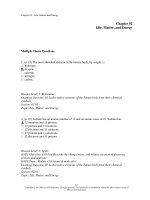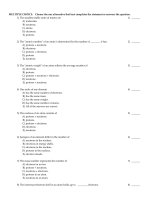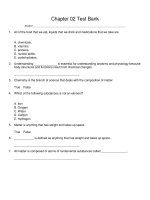Laboratory manual for anatomy and physiology 6th edition by marieb smith solution manual
Bạn đang xem bản rút gọn của tài liệu. Xem và tải ngay bản đầy đủ của tài liệu tại đây (669.25 KB, 4 trang )
2
E x e r c i s e
Organ Systems Overview
Time Allotment: 1½ hours (rat dissection—1 hour; human torso model—½ hour).
Multimedia Resources: See Appendix B for a list of multimedia resource distributors.
Homeostasis (FHS: 20 minutes, DVD, 3-year streaming webcast)
Homeostasis: The Body in Balance (HRM, IM, 26 minutes, DVD)
Advance Preparation
1. Make arrangements for appropriate storage and disposal of dissection materials. Check with the
Department of Health or the Department of Environmental Protection, or their counterparts, for state
regulations.
2. Designate a disposal container for organic debris, set up a dishwashing area with hot soapy water and
sponges, and provide lab disinfectant such as Wavicide-01 (Carolina) for washing down the lab benches.
3. Set out safety glasses and disposable gloves for dissection of freshly killed animals (to protect students
from parasites) and for dissection of preserved animals.
4. Decide on the number of students in each dissecting group (a maximum of four is suggested; two is probably best). Each dissecting group should have a dissecting pan, dissecting pins, scissors, blunt probe, forceps, twine, and a preserved or freshly killed rat.
5. Preserved rats are more convenient to use unless small mammal facilities are available. If live rats are used,
they may be killed a half hour or so prior to the lab by administering an overdose of ether or chloroform.
To do this, remove each rat from its cage and hold it firmly by the skin at the back of its neck. Put the rat
in a container with cotton soaked in ether or chloroform. Seal the jar tightly and wait until the rat ceases to
breathe.
6. Set out human torso models and a predissected rat.
Comments and Pitfalls
1. Students may be overly enthusiastic when using the scalpel and cut away organs they are supposed to
locate and identify. Have blunt probes available as the major dissecting tool and suggest that the scalpel be
used to cut only when everyone in the group agrees that the cut is correct.
2. Be sure the lab is well ventilated, and encourage students to take fresh air breaks if the preservative fumes
are strong. If the dissection animal will be used only once, it can be rinsed to remove most of the excess
preservative.
3. Organic debris may end up in the sinks, clogging the drains. Remind the students to dispose of all dissection materials in the designated container.
4
M02_MARI5487_05_C02_pp004-007.indd 4
Copyright © 2017 Pearson Education, Inc.
10/02/16 10:16 AM
Exercise 2
5
Answers to Activity Questions
Activity 6: Examining the Human Torso Model (pp. 15–16)
Digestive: esophagus, liver, stomach, pancreas, small intestine, large intestine (including rectum), gallbladder
Urinary: kidneys, ureters, bladder
Cardiovascular: heart, descending aorta, inferior vena cava
Endocrine: thyroid gland, pancreas, adrenal gland
Reproductive: uterus
Respiratory: lungs, bronchi, trachea, diaphragm
Lymphatic: spleen
Nervous: brain, spinal cord, medulla of adrenal gland
Copyright © 2017 Pearson Education, Inc.
M02_MARI5487_05_C02_pp004-007.indd 5
10/02/16 10:16 AM
R E V I E W
S H E E T
2
Name
E x er c ise
Lab Time/Date
Organ Systems Overview
1. Using the key choices, indicate the body systems that match the following descriptions. Then, circle the organ systems
(in the key) that are present in all subdivisions of the ventral body cavity.
Key:
cardiovascular
digestive
endocrine
integumentary
lymphatic
muscular
nervous
reproductive
respiratory
skeletal
urinary
urinary
1. rids the body of nitrogen-containing wastes
endocrine
2. is affected by removal of the adrenal gland
skeletal
3. protects and supports body organs; provides a framework for muscular action
cardiovascular 4. includes arteries and veins
endocrine
5. composed of glands that secrete hormones
integumentary
6. external body covering
lymphatic
7. houses cells involved in the body’s immune response
digestive
8. breaks down ingested food into its absorbable units
respiratory
9. loads oxygen into the blood
cardiovascular/endocrine 10. uses blood as a transport vehicle
muscular
11. generates body heat and provides for locomotion of the body as a whole
urinary
12. regulates water and acid-base balance of the blood
reproductive
and endocrine
integumentary
14. is damaged when you fall and scrape your knee
13. necessary for conception and childbearing
2. Using the above key, choose the organ system to which each of the following sets of organs or body structures belongs:
lymphatic
1. lymph nodes, spleen, lymphatic vessels
respiratory
4. trachea, bronchi, alveoli
skeletal
2. bones, cartilages, ligaments
reproductive
5. uterus, ovaries, vagina
endocrine
3. thyroid, thymus, pituitary gland
cardiovascular 6. arteries, veins, heart
6
M02_MARI5487_05_C02_pp004-007.indd 6
Copyright © 2017 Pearson Education, Inc.
10/02/16 10:16 AM
Review Sheet 2
7
3. Using the key below, place the following organs in their proper body cavity. Some responses may be used more than once.
Key:abdominopelvic cranial spinal thoracic
abdominopelvic
1. stomach
abdominopelvic
6. urinary bladder
thoracic
2. esophagus
thoracic
7. heart
abdominopelvic
3. large intestine
thoracic
8. trachea
abdominopelvic
4. liver
cranial
9. brain
spinal
5. spinal cord
abdominopelvic
10. rectum
4. Using the organs listed in item 3 above, record, by number, which would be found in the following abdominopelvic regions:
3, 6, 10
1. hypogastric region
1, 3, 4
4. epigastric region
3
2. right lumbar region
3
5. left iliac region
3
3. umbilical region
1, 3
6. left hypochondriac region
5. The five levels of organization of a living body, beginning with the cell, are as follows: cell, tissue
organ
, organ system
,
, and organism.
6.Define organ: A structure composed of two or more tissues that performs a specialized function
7. Using the terms provided, correctly identify all of the body organs provided with leader lines in the drawings below. Then
name the organ systems by entering the name of each on the answer blank below each drawing.
Key: blood vessels
brain
heart
kidney
nerves
sensory receptor
spinal cord
ureter
urethra
urinary bladder
Brain
Sensory receptor
Kidney
Heart
Spinal cord
Ureter
Nerves
Urinary bladder
Urethra
Blood vessels
1. Nervous
2. Cardiovascular
3. Urinary
Copyright © 2017 Pearson Education, Inc.
M02_MARI5487_05_C02_pp004-007.indd 7
10/02/16 10:16 AM









